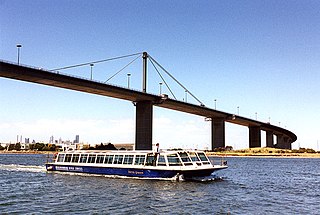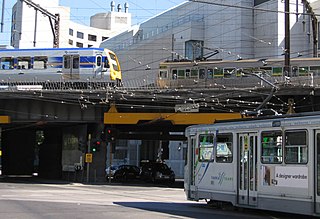
The West Gate Bridge is a steel, box girder, cable-stayed bridge in Melbourne, Victoria, Australia, spanning the Yarra River just north of its mouth into Port Phillip. It carries the West Gate Freeway and is a vital link between the Melbourne central business district (CBD) and western suburbs, with the industrial suburbs in the west, and with the city of Geelong 80 kilometres (50 mi) to the south-west. It is part of one of the busiest road corridors in Australia. The high span bridge was built to allow large cargo ships to access the docks in the Yarra River.

The Melbourne Convention and Exhibition Centre, colloquially referred to as "Jeff's Shed," is a group of three adjacent buildings next to the Yarra River in South Wharf, an inner-city suburb of Melbourne, Victoria, Australia. The venues are owned and operated by the Melbourne Convention and Exhibition Trust.

Flinders Street is a street in Melbourne, Victoria, Australia. Running roughly parallel to the Yarra River, Flinders Street forms the southern edge of the Hoddle Grid. It is exactly 1 mi (1.6 km) in length and one and a half chains in width. It is named for the explorer Matthew Flinders, erroneously credited with discovering Port Phillip at the time of its naming. It extends eastwards as far as Spring Street and the Treasury Gardens and westwards to Spencer Street originally, but now continues past Batman's Hill to the Melbourne Docklands. As the closest street to the river, Flinders Street serviced Melbourne's original river port. Customs House, now the site for Victoria's Immigration Museum, is on Flinders Street.

The Sandridge Bridge is a historic bridge, originally carrying a railway, over the Yarra River in Melbourne, Victoria, Australia. It runs diagonally to the river's banks and is 178.4 metres (585 ft) long. In 2006 it was redeveloped as a pedestrian and cycle path featuring public art. It is the third bridge on the site and is listed on the Victorian Heritage Register.

Colin Campbell Watson was an Australian rules footballer in the Victorian Football League.

Princes Bridge, originally Prince's Bridge, is a bridge in central Melbourne, Australia that spans the Yarra River. It is built on the site of one of the oldest river crossings in the city, and forms a gateway into the central city from the south. The bridge connects Swanston Street on the north bank of the Yarra River to St Kilda Road on the south bank, and carries road, tram and pedestrian traffic. The present bridge was built in 1888 and is listed on the Victorian Heritage Register.

The electoral district of Melbourne is an electorate of the Victorian Legislative Assembly. It currently includes the localities of Docklands, Carlton, Melbourne, East Melbourne, West Melbourne, North Melbourne, Parkville, Newmarket, Kensington and Flemington, and includes Melbourne University. The district has been in existence since 1856.

The Chandler Highway is a short road in the inner eastern suburbs of Melbourne. It runs from Heidelberg Road in Alphington, crosses the Yarra River, then continues across the Eastern Freeway, then terminates at an intersection with Princess Street and Earl Street. Its total length is less than 2 kilometres, leading to the claim that it is "the shortest highway in the world". It was named after a prominent local businessman and politician A. E. Chandler, who was instrumental in pushing through the development of the Outer Circle railway.

The King Street Bridge carries King Street over the Yarra River in Melbourne, Australia. The bridge continues south as an elevated viaduct, with the Crown Casino built around it in later years.

The Queen's Bridge is a historic road bridge over the Yarra River in Melbourne, Victoria, Australia. The bridge was built in 1889 and has five wrought iron plate girder spans, and is listed on the Victorian Heritage Register. The bridge was built by contractor David Munro, and replaced a timber footbridge built in 1860.

The Charles Grimes Bridge is a dual-carriageway bridge that carries the Docklands Highway over the Yarra River in the Docklands precinct of Melbourne, Australia. It was named after New South Wales surveyor general Charles Grimes, who was the first European to see the Yarra River.

The Flinders Street Viaduct is a railway bridge in Melbourne, Australia. Made up of six tracks built at different times, it links Flinders Street station to Southern Cross station, forming the main connection between the eastern and western parts of the Victorian rail network.

The Cremorne Railway Bridge crosses the Yarra River three kilometres south-east of Melbourne connecting Richmond and South Yarra stations on the Frankston, Pakenham, Cranbourne, and Sandringham railway lines.

Richard William "Fatty" Lamb was an Australian racing cyclist who competed on both road and track, as was typical of Australian cyclists of the era such as Hubert Opperman. Throughout his career, Lamb was associated with Malvern Star Bicycles and Bruce Small.

Johnston Street Bridge is a concrete road bridge crossing the Yarra River between the Melbourne suburbs of Abbotsford and Kew.
William Arthur Purnell F.R.A.I.A., generally known as Arthur Purnell, and sometimes A W Purnell, was an Australian born architect who practiced in Canton, China in the 1900s, and from 1910 mainly in Melbourne, Australia. He is most noted for the few designs in Melbourne that include Chinese references.

Estelle Mary (Jo) Sweatman (1872-1956), was an Australian painter. She was a founding member of the Twenty Melbourne Painters Society.

Margery Pitt Withers was an Australian artist.

Norah Gurdon was an Australian artist. Her first name is often misspelled Nora in many articles reviewing her work.

Doncaster–Eltham Road is a major arterial road in the north-eastern suburbs of Melbourne, Victoria, Australia. This name is not widely known to most drivers, as the entire allocation is still best known as by the names of its constituent parts: Fitzsimons Lane and Williamsons Road. This article will deal with the entire length of the corridor for sake of completion, as well to avoid confusion between declarations.























